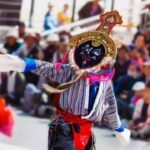Tibetan opera, known as “Ache Lhamo,” is an integral part of Tibetan society. It is a distinctive form of theatre that combines storytelling with folk dances and songs. The most notable display of Tibetan dances can be seen in Tibetan Opera, Lhamo, believed to have originated from a performance by seven sisters. Ache Lhamo is a term used to describe various Tibetan drama forms, which comprise a vast theatrical system influenced by the unique geographical and cultural characteristics of settlements on the Tibetan plateau. Lhamo has a six-hundred-year history and primarily focuses on subjects related to Buddhism.
The eight classical operas, namely Prince Norsang, Gyalsa Balsa, Gyalpo Drime Kunden, Maiden Dolwa Sangmo, Brothers Donyod and Donmed, Princess Zukyi Nyima, Prince Pema Woebar, and Maiden Nangsa Woebum, showcase captivating music, as well as exquisite masks and attire.
Thangtong Gyalpo – Founder of Tibetan Opera
Thangtong Gyalpo, a renowned Tibetan Siddha, extensively journeyed in Tibet and other eastern regions. He constructed numerous temples and metal bridges and established monasteries in Dergé and other locations. It is believed that he embodies the mind aspect of Guru Rinpoche. Thangtong Gyalpo, known as the King of the Empty Plain, is renowned for founding Ache Lhamo, the Tibetan opera, and constructing multiple iron suspension bridges to facilitate travel and pilgrimage in the Himalayas. To finance the bridge construction, he formed a song and dance troupe comprising seven sisters.
Tibetan opera to finance the construction of Bridge
It is said that he constructed 108 iron-chain suspension bridges, although another version states that he built 58 suspension bridges and 118 ferry crossings. The most renowned bridge he created is located near modern Chushul (Qüxü) over the Yarlung Tsanpo. Depictions of him in murals often portray him with lengthy white hair, holding chain links from his bridges.
Built by Thangtong Gyalpo, the Chakzam Bridge, one of his iron chain suspension bridges, was located about 65 km from Lhasa at Tsangpo. In 1948, the bridge still existed, although it was no longer used and required repairs. Instead of using the bridge, people crossed the river by ferry. The old bridge consisted of two thick chains fastened to sturdy wooden beams beneath the pillars. From the top of the pillars, 12′ (4 m) ropes were suspended from the chains. These ropes supported wooden boards measuring a yard (1 m) in length and a foot (30 cm) in width, allowing for the passage of a single person. The bridge spanned a distance of one hundred paces.
Bands, musicians and musical instruments
Before the democratic reform in 1959, Langdo, a form of Tibetan opera, was usually sung without accompaniment. Even on important occasions when people would sing and dance, only drums and cymbals were used. Today, these accompaniments are still utilized by some local bands.
The Tibetan Opera Troupe has grown significantly over time, and an increasing number of national and Western musical instruments have been incorporated into performances. The Tibetan Opera Troupe has developed a unique band system that prominently features Tibetan musical instruments such as the Piwang, Tibetan Dramnyen, Cymbal, Drum, Flute, and Tibetan keyboard.




















